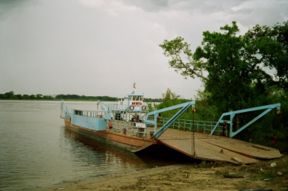- Meta River
-
Meta 
Ferry over the Rio Meta on the road from Puerto Ayacucho to San Fernando de Apure in VenezuelaOrigin Colombia Mouth Orinoco at Puerto Carreño Basin countries Colombia, Venezuela Length 804 kilometres (500 mi) Source elevation c. 1,300 metres (4,300 ft) Basin area 93,800 square kilometres (36,200 sq mi) The Meta River is formed in the Meta Department, Colombia by the confluence of the Humea, Guatiquía and Guayuriba rivers. It flows east-northeastward across the Llanos Orientales plains of Colombia through an ancient fault. The Meta forms the northern boundary of Vichada Department, first with Casanare Department, then with Arauca Department, and finally with Venezuela, down to Puerto Carreño where it flows into the Orinoco.
The Meta river is 804 kilometres (500 mi) long and its drainage basin is 93,800 square kilometres (36,200 sq mi). The Meta divides the Colombian llanos in two different realms: the western portion on the left is more humid, receives the relatively nutrient-rich sediments from the Andean mountain range and therefore soils and tributaries are also nutrient-rich, while the eastern portion, high plain or altillanura, drains not to the Meta river but to the Orinoco, has a longer dry season and soils and surface waters are oligotrophic (nutrient poor).
The major tributaries of the Meta are the Cravo Sur, the Casanare, the Cusiana, the Upía and the Manacacías.
Economics
Starting at Puerto López the Meta becomes navigable, and thus is an important component of the trade across the Colombian and Venezuelan llanos.
Coordinates: 6°11′43″N 67°27′23″W / 6.19517°N 67.4564°W
Tributaries of the Orinoco From the Guiana Highlands 
From elsewhere Inter-basin links Casiquiare canal (with Amazon)Categories:- Rivers of Colombia
- Rivers of Venezuela
- Orinoco basin
- Colombia–Venezuela border
- International rivers of South America
- Colombia geography stubs
- Venezuela geography stubs
Wikimedia Foundation. 2010.
